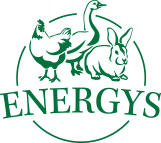Rabbits
Poultry
Laying hens
Quails
Guinea pigs
Pigs
Ostriches
Sheep and goats
Pigeons
Pheasants
Forest animals
Breeding Pigeons – Part 2
At the end of the 1980s and in the 1990s small pigeon farms started to be established here, and there were also larger ones with 1,000 breeding pairs for the purpose of producing meat squabs.
Categories of meat breeds do not currently occur in any standard. Suitable breeds are in the utility pigeons category. An example in our Slovak breeds is the Piešťany Giant. The French Cauchois is also sought after. The pallet of pigeons is wide-ranging, but only those where one pair is able to rear around 15 or more young a year can be successful as a meat breed. In extensive farming, the weight of young pigeons should be around 550 to 700 grams, in intensive farming the weight of young pigeons should approach 1,000 g. With regard to the fact that the majority of breeds are bred for the beauty of their appearance and competing at exhibitions, fertility and care for offspring fell for many of them.
Pigeon meat is currently only consumed in the breeder’s family. Information about the production of pigeon meat is not included in statistical data, because pigeons are not farm animals in Slovakia. Pigeon breeding and slaughtering is also not dealt with by Decree No. 230 Coll. of 23 July 1998 on breeding and slaughtering meat animals.
Feeding pigeons
Today, feeding pigeons is relatively simple. They can be fed in the classic way using cereals, such as wheat, barley, corn, sunflowers, buckwheat, etc., as well as using new, full-value granulated feeds from De Heus. The company focuses on selling compound feeds that can be used for all pigeon breeds. The specific requirements of individual breeders, however, concern how to feed different pigeons. The dealer sells them under the Energys Hobby brand to breeders and enables them to select products depending on the energy need, i.e. compound feeds for pigeons with higher or lower energy contents.
A granulated compound feed for pigeons with a lower energy content. It can be used for all pigeon breeds with regard to breeders’ requirements. It provides all important substances, because pigeons cannot separate it like a grain mixture.
Complete feed in the form of granules with a higher energy content. It can be used for all pigeon categories and breeds. It provides all important substances. This mixture is especially suitable for meat breeds, but, for example, also for homing pigeons in the racing season.
A breeder therefore does not have to purchase individual cereals for mixtures, but has everything needed in an optimum composition in a granulated compound feed. When transitioning to feeding using a granulated compound it is important to gradually add the compound to the current feed and gradually increase the quantity, until the pigeons are only eating granulated feed.
Feed store
When establishing a breeding operation, a breeder should think about where he will store the feed for the pigeons. A dry room that can be ventilated and is secured against intrusion by small rodents, mice and rats is appropriate for this purpose. Bags with feed are stored on pallets. A breeder can therefore create supplies of feed for a longer period, for half a year or a whole year. One pair of a heavy meat breed in a productive facility with a full number of young (15 on average) to slaughter maturity consumes 50 kg of feed per year (Havlín, J., 1997). The mathematics is simple, for five pairs and young a breeder needs 250 kg of feed.
Accommodation
The least demanding method of accommodation in terms of work by the breeder is to keep pigeons in a sectional pigeon coop that is linked to an aviary. A section is to be divided into two parts, it is enough to have a wire netting barrier in which there is a door. In the same way, the aviary is divided into two parts, to which each section is linked. Double-booths are installed in a section, one for each pair. This is important, because while young pigeons are maturing in one booth, the mother pigeon is laying or sitting on new eggs in the other. If the breeder chooses a section size of 300 x 300 cm, after division he will have two compartments. The shelf booths with dimensions of 30 x 30 x 30 cm, two next to each other, in four lines one on top of the other. The lower booths should have a base that is 20 cm high so that there is a good view, as well as easy operation and cleaning. A base must be full, made of boards, so that young that fall out of the nest prematurely cannot hide under the booths. If a breeder prepares one more row, the system can serve for the rearing and reproduction of 8 pairs of pigeons.
The second section does not have to have booths, if the breeder decides to rear pigeons for further breeding, for use in the next year, it is necessary to fit the compartment with seats. The seats can be shelf seats, each with a width of landing area of 12 cm, length of 30 cm and height of 30 cm. The number of seats is the same as the expected number of weaned young, or preferably higher. In the event that a breeder breeds auto-sexing pigeons (Texans), there is no problem, he separates the best females and males, pairs should be able to choose each other independently. This assumes that all the females are not related to any of the males.
Two compartments are suitable so that a breeder can start with a smaller number of pigeons, e.g. five pairs, and progressively, every year, expand his flock. The idea is to fill a pigeon coop at one time with young, unrelated pairs, for hygiene and health reasons.
SELECTION OF BREEDS
It is up to a breeder to decide what breed of pigeons he wants to use in extensive or intensive farming for slaughter purposes. For intensive breeding we would like to introduce the two breeds that are most frequently used, the French Mondain and the American Texan.
MONDAIN
The Mondain is one of the heaviest pigeon breeds. It was bred as a meat breed with high utility in intensive facilities. It helped establish several farm breeds. It is bred throughout the world. In the list of breeds of the European Association of Breeders (EE) it is classified among utility breeds; here it is regarded as a utility pigeon, under number 6.
The Mondain has a large body frame with a wide and deep breast. It carries its body horizontally, its head is light and relatively small, the whole figure is short, as are its legs. It practically does not fly, so it is suitable for being raised in an aviary. Breeders release them from an aviary not for flying, but to move freely around a garden. When they get used to it, they are happy to be chased back to their place in the aviary.
When breeding them, leading breeders use the French standard. In Slovakia, there is a good breeding base for this breed and new breeders should contact members of a special breeding club for breeding material. Its members are involved not only in improving Mondains, but also Texans. In 2008, the French club partially altered the standard and one of the changes was an alteration to the weight, a minimum of 1,000 g for a female and a minimum of 1,100 g for a male, where the upper limit is not set. They are ringed with 11 mm rings.
In utility breeding, the Mondain is an almost completely American matter. Here, French Mondains are imported from Hungary and Germany. They are large pigeons that were originally bred as utility birds in Italy and France, but under German influence improvement for exhibition purposes predominated. It is typical for them to have a relatively small head and very low legs, but rich feathering that creates the impression of extraordinary robustness. Emphasis is placed on the compact nature of the body in America. This applies also to those that retained the French name and are used in large facilities, in particular in blue-striped (black-striped) colouring.
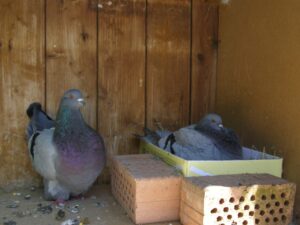
TEXAN
The Texan (Auto-sexing Texan Pioneer) is a relatively young breed, created in the 1950s in the USA. However, it spread rapidly around the world and is also bred in the Czech Republic. It has one property that is very valuable for utility breeding – it is auto-sexing. This means that both sexes can be distinguished by the colour of their feathering (males are almost white, with an uncertain colouring only on the neck, females have various light pigeon colours); the sex of young pigeons can be determined by the length and density of their down (young males are almost naked, females are covered in down). This auto-sexing originally occurred in the utility king and, by cross-breeding, was transferred to other breeds (for example to utility pigeons based on the homing pigeon). Only in the case of the Texan is the colouring exclusive, there are no other options.
The Texan is a large utility pigeon, with a relatively small and slightly tilted head, on low legs, but with a large, wide breast. Adults weigh from 740 to 930 g, young from 700 to 800 g. The best utility pigeons are smaller, with a compact, meaty body and less rich feathering. In order to retain the required fertility, the live weight should not exceed 1,000 g. They are ringed with 11 mm rings. They are suitable for being raised in an aviary. In they are raised free, flying should be limited.
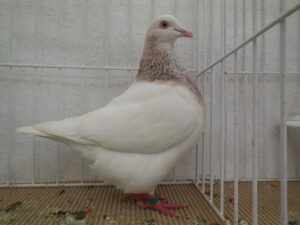
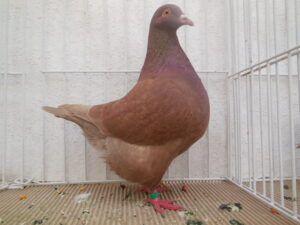
Related posts
1. March 2021
At the end of the 1980s and in the 1990s small pigeon farms started to be established here, and there were also larger ones with 1,000 breeding pairs for the purpose of producing meat squabs.
11. December 2020
Breeders organised in the Czech and Slovak breeders associations are currently involved in breeding pigeons. The breeding aims of organised pigeon breeders are very varied, as pigeon breeds are various. There are also differences in the methods for breeding, accommodation, treatment, feeding, for some training and competitions for some utility in the form of meat.
Related products
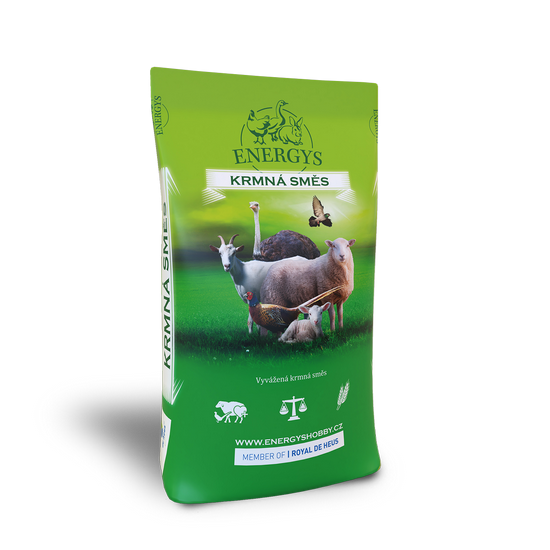
PIGEON PREMIUM
A complete feed in the form of granules with a higher energy content. It can be used for all categories and breeds of pidgeon. It provides all important substances. This mix is especially suitable for meat breeds, but also for example for postal pidgeons in the competition season.

PIGEON UNI
A granulated complete feed mix for pidgeons with a low energy content. It can be used for all breeds of pidgeons depending on the requirements of breeders. It ensures a supply of all importatnt substances because the pidgeons can’t separate it like mixed mixes of grains.
